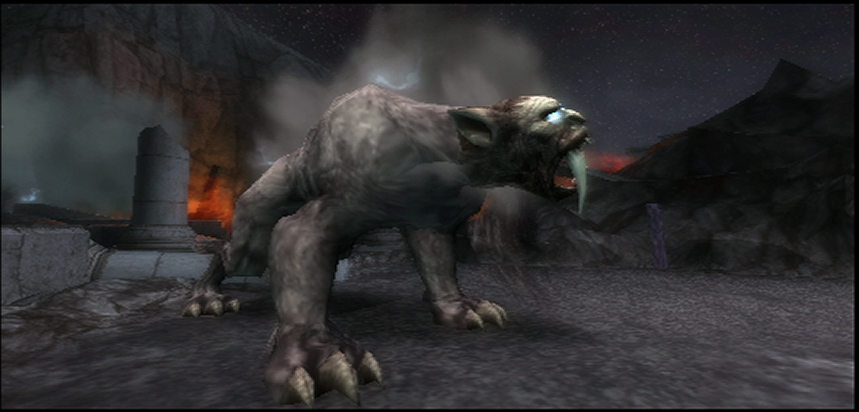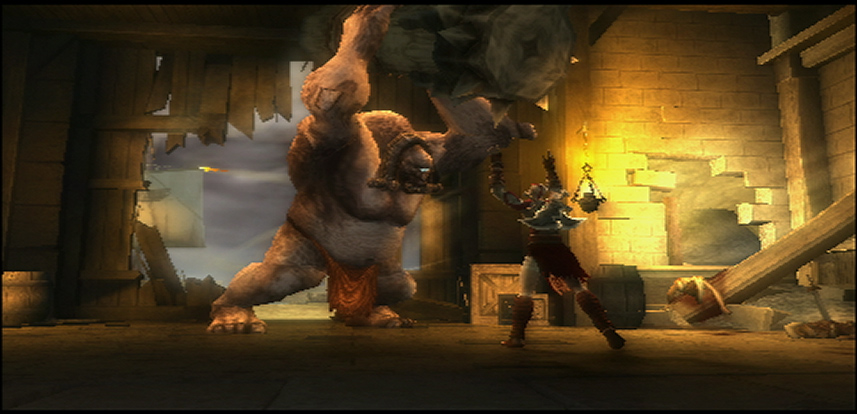God of War: Chains of Olympus Screenshot Comparison
Check out how God of War: Chains of Olympus compares to both God of War and God of War II.
God of War: Chains of Olympus looks fantastic. Normally we'd toss in a "for a portable game" qualifier, but we really don't need to in this case. Chains of Olympus looks better than most PSP games, and easily hangs in the looks department with the best PlayStation 2 games. The graphics are even more impressive because Ready at Dawn built the game specifically for the PSP. The original God of War and God of War II pushed the PlayStation 2 hard, and it would seem that most of the work was already done. However, the developers couldn't reuse much from the previous games. The vast majority of Chains of Olympus is totally new, and what looks familiar is actually built for the PSP and not ported from the PS2 games.
Chains of Olympus actually looked good enough for us to dust off our original God of War image comparison to see just how good the PSP game looked in comparison to its PlayStation 2-based siblings. We went through Chains of Olympus and tried our best to match up some of the scenes from the previous two games to see some of the differences. For the most part, Chains of Olympus holds its own against both games. In addition, Ru Weerasuriya, vice president of creative development at Ready at Dawn Studios, had the time to answer a few questions we had about Chains of Olympus.
Mouse over each caption to change images.GameSpot: How is developing for the PSP more challenging than developing for the PS2?
Ru Weerasuriya: Well, when you work on a system that has the potential of rivaling games on a home console but that does that in a smaller, more complex package, you have to pull off a few miracles to achieve something that people will undoubtedly compare to its predecessors, namely God of War & God of War II. Developing for the PSP requires a lot more discipline than developing for other consoles because of slower CPU speed, a single bus to transfer all data, etc. Everyone knows that the PSP does not have as much power as the PS2, and thus it takes that much more to achieve similar results on the handheld. It becomes a game of give-and-take and fine-tuning, where everyone on the team has to be more mindful of each other's work.
When all is said and done, I think one of the biggest challenges of working on the PSP is the lack of teams that are truly testing the hardware. The only way to really make development easier is to see more developers pushing the PSP, creating better technology and better games. It's that type of competition that helped the PS2 and made working on it easier with time. Seeing what's possible incites people to emulate or do better. Ultimately a console is only as good as the developers that work on it and the games that are made for it. Hopefully, the PSP will have its share of great games over its lifetime.
GS: Were you able to use any assets from the original PS2 games, or is God of War: Chains of Olympus all home cooking from Ready at Dawn?
RW: We started off by evaluating what could be reused from the previous games, but we soon found out that we had to start everything anew, from models and textures to animations, even when we were just duplicating assets. In many ways, things would have been way easier had we reused previous assets, like models or especially the combat system. But building everything from the ground up was one of the things that made us better understand the franchise and ultimately make a true successor to the previous God of War games.
GS: Overall, would you say that the graphics in God of War: Chains of Olympus are better, worse, or about the same as the graphics in the PS2 games?
RW: It all depends what you look for. At times, we found ourselves admiring some of the work Santa Monica had done and were hard-pressed to top it. And at other times, we achieved visuals that I believe are better than what you saw in previous games simply in the mood they set and their immersion factor. A lot had to do with the overall package rather than each individual asset. Our goal was always to look at the bigger picture and relay the story and design moments as best we could visually.
GS: How do the character models in God of War: Chains of Olympus compare to those in God of War II? Did you have to make any major changes to Kratos for the small screen?
RW: We had to adapt to the strict requirements of the PSP and make sure that, first and foremost, the silhouettes of the characters read well on the small screen. There was quite a lot of work that went into creating a slightly different look than what had been done in the first two God of War games. Kratos himself had a makeover. His model was tweaked to accentuate the areas that would be most visible to the player. His proportions were changed. His textures were reworked and his animations were overhauled since in any case, our rig was proprietary and therefore different to the one Santa Monica had worked with.
GS: We found that maps gained a lot more detail when we went from God of War to God of War II. How do the levels compare in Chains of Olympus?
RW: We followed in the footsteps of God of War II in that respect, albeit on the smaller PSP package. With the realistic nature of the visuals, we had to make sure that we could get a lot out of the maps, like the skin details on the creatures (the cyclops and basilisk are great examples of that), to the textures of the large-scale environments. Even the water needed to look as good if not better than on PS2; the addition of caustics and surface waves just made it come to life. When making this game, we knew that the fans would not forgive us anything just because we are on a different platform, so the prerogative was to not lose anything in the visuals from the past games to this one.


GS: How has the unlocked 333MHz clock speed improved the game? Does the game have any areas that would have punished the original 222MHz clock?
RW: I would hope that the game would be as enjoyable at 222MHz as it is at 333MHz, and during the time we were on the old firmware, it was. 333MHz allowed us to add to the experience we had already created; more enemies, more particles, more everything... What made things simple for us was that our tech didn't have to change at all. The Ready at Dawn Engine is fully scalable and was developed without the constraints of a specific platform. It runs on PSP, but also on PC, PS3, and Xbox 360. So when Sony announced the new firmware, it literally was like flipping a switch. We had more freedom in increasing combat difficulty, visuals got that much more detailed, and the artists went wild.
Of course, after working in 333MHz there are areas that would probably not play as well were we to go back to 222MHz, especially scenes with expansive vistas such as the ones in Helios Temple or Hades, or combat encounters with multitudes of enemies. That said, I've made the mistake of running the devkit in 222MHz plenty of times without gameplay really being impacted all that much. Again, it all depends which part of the game you're in.
Got a news tip or want to contact us directly? Email news@gamespot.com





















Join the conversation